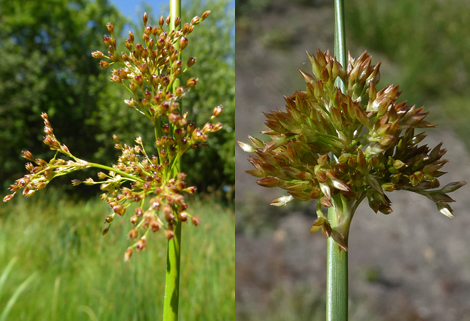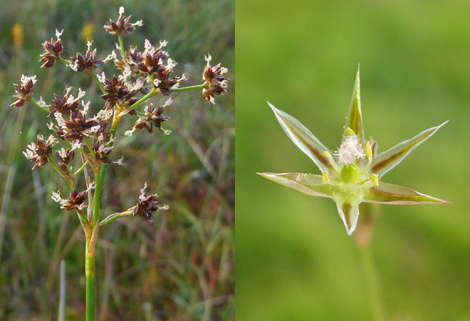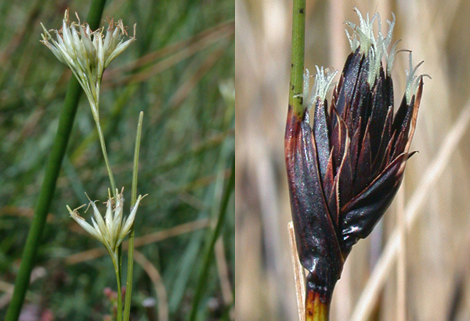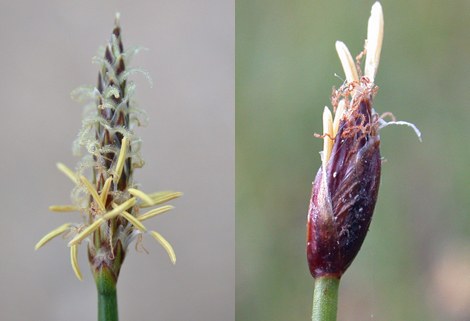Rushes and Rush-like Plants
The differences between rushes, sedges and their relatives are described in greater detail on a separate page, which you can visit by clicking here. But in essence, it should be remembered that true rushes (members of the family Juncaceae) have flowers with six bract-like petals and both male and female floral structures (perfect flowers). Flowers of the sedge family lack the six tepals of the rush family and tend to have just a single, green or brown, bract which often conceals the flower except when the anthers or stigmas protrude (rather like they do in the grasses). True sedges in the genus Carex have imperfect flowers, so each flower will be either male or female (not both), but the members of the sedge family covered here have perfect flowers, so the presence of just a single bract at the base of each flower - and often more less entirely covering it - is an important feature to look for.
The main purpose of this page is to attempt to break this group up into bite-sized chunks, so that the pages you are led to do not get too big by containing a large number of species. At worst, if you follow a link from here and do not see your plant, return to this page and try another link.
Use the photos below to narrow your search to a group, then click on the picture to go to the next stage.
 |
Rushes
True rushes in the genus Juncus fall into two main groups - those that have leaves or leaf-like bracts and those that have dispensed with leaves and have tubular, green stems that fulfil the function of leaves by photosynthesising. The leafless species typically have long, slender stems that may be packed into tight clumps, or individually arising from the root system to produce spreading stands of stems. In the clump-forming, leafless species, the flowers are clustered relatively tightly at the top of the stem, though a single bract behind the flower cluster may be upright and appear like an extension of the stem (thus the 'stem tip' is actually the tip of a stem-like bract). |
 |
Rushes
Leafless species of Juncus rushes that form spreading colonies of stems typically have flower spikes that are rather open and many-branched, making them rather similar to some of the club-rushes at first glance. However, a closer look at the individual flowers will reveal that each has six tepals (representing brownish sepals and petals) and this identifies them as members of the rush family (Juncaceae) and not the sedge family (Cyeraceae). The leaf-bearing rushes have leaves that may be tubular like the stems, or which may be two-faced, like those of grasses. In the latter, the flower structure and lack of nodes on the stem will tell them from grasses. |
 |
Wood-rushes
The wood-rushes form a small but rather variable group of plants. The flowers are typically carried in club-like clusters, resembling some of the club-rushes and their relatives, but a close look at the individual flowers will reveal that the flowers have six tepals, so they are clearly in the rush family (Juncaceae). One feature that clearly indicates that you have a wood-rush can be found by looking at the leaves. The leaves are broadly flattened and grass-like, but more importantly, they have distinctive, long, white hairs around the leaf margins and - particularly - around the base of the leaf where it joins the stem. Despite much variation in the appearance of the flowerheads, this feature is worth checking for and will lead you in the right direction. |
 |
Wood-rushes
Though the individual flowers of wood-rushes help to identify them, the arrangement of the flowerheads can be very variable. While our commoner native species have club-like heads that open out with age, some of the other species have rather more open heads that could be more easily mistaken for other plant groups. Here again, it is important to remember to check the structure of individual flowers (if they are mature enough to study fully) for the presence of six tepals and also to remember the white hairs on the leaves, as detailed in the previous section. |
 |
Club-rushes
The term 'club-rush' is used as an English name for at least five different genera in the UK, so they are rather variable in appearance, with one group (Isolepis) more closely resembling the spike-rushes. However, these are all members of the sedge family (Cyperaceae) and therefore have reduced flowers, each with a single bract at its base. The flowers are clustered into tight, often oval, spikelets and these spikelets may themselves be carried tightly clustered together, or carried more openly on spreading branchlets. Like the rushes, this group includes both leafless species with tubular, green stems and species with flattened, sedge-like leaves.
Great Fen-sedge resembles these club-rushes and can be found in this group; it differs in its flowers being arranged in several clusters along the stem, rather than in a single head at the top of the stem.
|
 |
Bog-rushes & Beak-sedges
Plants falling under the broad heading of 'club-rushes' include the bog-rushes and beak-sedges. In these groups, the flowerheads can somewhat resemble other groups, with some beak-sedges looking like wood-rushes. In this case, the lack of white hairs on the leaves will be a good separating feature, while a detailed look at the individual flowers (which may require a hand lens!) will reveal the presence of a single bract with each flower and not six, bract-like tepals. |
 |
Cottongrasses
The cottongrasses can be rather confusing at first, since the flowerheads look rather like those of true sedges in the genus Carex, as do the flattened leaves. But once the seedheads develop, they become readily identifiable by the mass of cottony hairs that elongate and form plumose heads that are such a distinctive feature of acid bogs. These cottony heads can last a long time and often, a few of the heads from the previous year can be found to assist in identification. These cottony strands develop from bristles at the base of each flower. Such bristles are present in other sedge allies but reamin small so are often not noticed. |
 |
Galingales
The genus Cyperus is largely a tropical and warm temperate group of plants and includes the flat-sedges and galingales. These plants are closely related to sedges in the genus Carex with a similar look to their leaves and stems, but they differ in the arrangement of the flowers. The flower spikes consist of radiating branches (rather like thise of some of the club-rushes) and the spikelets within the flowerhead are arranged in double rows, giving the appearance of a miniature head of wheat. These heads opften have long, leaf-like bracts projecting from their bases and these often radiate out like the spokes of an umbrella.
Most species of galingale in the UK are introduced, so may often be found in non-wetland habitats in urban areas. |
 |
Flat-sedges
The flat-sedges include the galingales detailed above and also a couple of small, inconspicuous and scarce, wetland species in the genus Blysmus. Flat-sedges have flower spikes with the individual flowers arranged in a double-rowed spike, rather like those of some of the grasses, such as wheat. The group gets its name from the two-sided arrangement of the flowers, which results in a flattened appearance when viewed from the side. |
 |
Spike-rushes
Some members of the sedge family have their flowers clustered into a small, tight spike, which is carried at the very tip of the stem - or sometimes with just a short, stem-like extension beyond the flower spike, provided by a slender bract. These species tend to be mostly rather small, often with the entire plant no more than 10cm in height (or even less!) and are thus easily overlooked or passed off as young individuals of larger sedge or rush species. The plants are typically leafless and have rounded, green stems with a flower spike at the tip of each stem. |